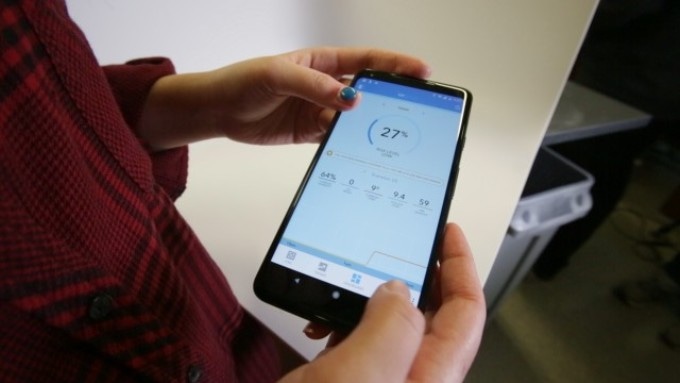Jan 10 2018
A Northwestern University professor, working together with the international beauty company L’Oréal, has built the world’s smallest wearable device. The wafer-thin, feather-light sensor can fit on a fingernail and precisely measures a person’s exposure to UV light from the sun.
 UV Sense, wearable technology that sticks to the finger nail, measures UV exposure and sends safety information to an app. (Photo credit: Northwestern University)
UV Sense, wearable technology that sticks to the finger nail, measures UV exposure and sends safety information to an app. (Photo credit: Northwestern University)
The device, as light as a raindrop and smaller in circumference than an M&M, is powered by the sun and contains the world’s most advanced and accurate UV dosimeter. It was introduced on Sunday, January 7, at the 2018 Consumer Electronics Show in Las Vegas and will be known as UV Sense.
“We think it provides the most convenient, most accurate way for people to measure sun exposure in a quantitative manner,” said Northwestern engineer John A. Rogers. “The broader goal is to provide a technology platform that can save lives and reduce skin cancers by allowing individuals, on a personalized level, to modulate their exposure to the sun.”
UV Sense does not have any moving parts or battery, is waterproof, and can be attached to virtually any part of the clothing or body, where it uninterruptedly measures UV exposure in a unique accumulation mode.
Rogers said the device, developed in collaboration with L’Oréal, is designed to stick on a thumbnail - a stable, rigid surface that guarantees robust device adherence. It is also an ideal location to measure exposure to the sun.
It is orders of magnitude smaller than anything else out there. It also is one of the few sensors that directly measures the most harmful UV rays. Further, it simultaneously records body temperature, which is also very important in the context of sun exposure.
John A. Rogers
Users will just have to download an app on their smartphone, and then swipe the phone over the device to view their exposure to the sun, either for that particular day or over a period of time. The app can propose other, less UV-intense times for outdoor activities or give peace of mind to people who are worried about overexposure.
“UV Sense is transformative technology that permits people to receive real-time advice via mobile phone messages when they exceed their daily safe sun limit,” said June K. Robinson, M.D., research professor of dermatology at Northwestern University Feinberg School of Medicine.
Roger’s research team at Northwestern, in partnership with Robinson and researchers at Feinberg, have received approximately $2 million grant from the National Institutes of Health to deploy the fingernail UV sensors in human clinical studies of sun exposure in partnership with subjects who are at risk for melanoma. The first pre-pilot field trials began in December.
Sunlight is the most potent known carcinogen. It’s responsible for more cancers than any other carcinogen known to man, and it’s everywhere -- even in Chicago.
John A. Rogers
On an average, half the U.S. population endures sunburn once a year or more, he said, and there are over a million melanoma survivors in the U.S. alone.
Guive Balooch, Global Vice President of L’Oréal’s Technology Incubator, said the company’s research reveals that overexposure to UV rays is a leading health and beauty concern of consumers around the world.
“With this knowledge, we set out to create something that blends problem-solving technology with human-centered design to reach even more consumers who require additional information about their UV exposure,” Balooch said. “Whenever we develop a new technology, our goal is to make an enormous global impact by enhancing consumers’ lives.”
Rogers said the aesthetic design attributes of UV Sense are also crucial as they can help remove barriers to adoption. The device can be made in any color with any logo, pattern, or branding.
Last year, Rogers’ innovative invention, the “Microfluidic System on the Skin,” was chosen as an exhibit at New York’s Museum of Modern Art. As the Rogers Lab at Northwestern continues to design new products, Rogers believes the technology his team created will have other applications that can aid consumers properly monitor their health.
“What also excites me is that there’s novelty at the level of the academic science,” said Rogers, the Louis Simpson and Kimberly Querrey Professor of Materials Science and Engineering, Biomedical Engineering and Neurological Surgery in the McCormick School of Engineering and Northwestern University Feinberg School of Medicine. “The resulting technology has strong potential for positive impact on human health.”